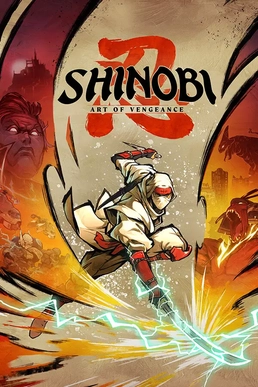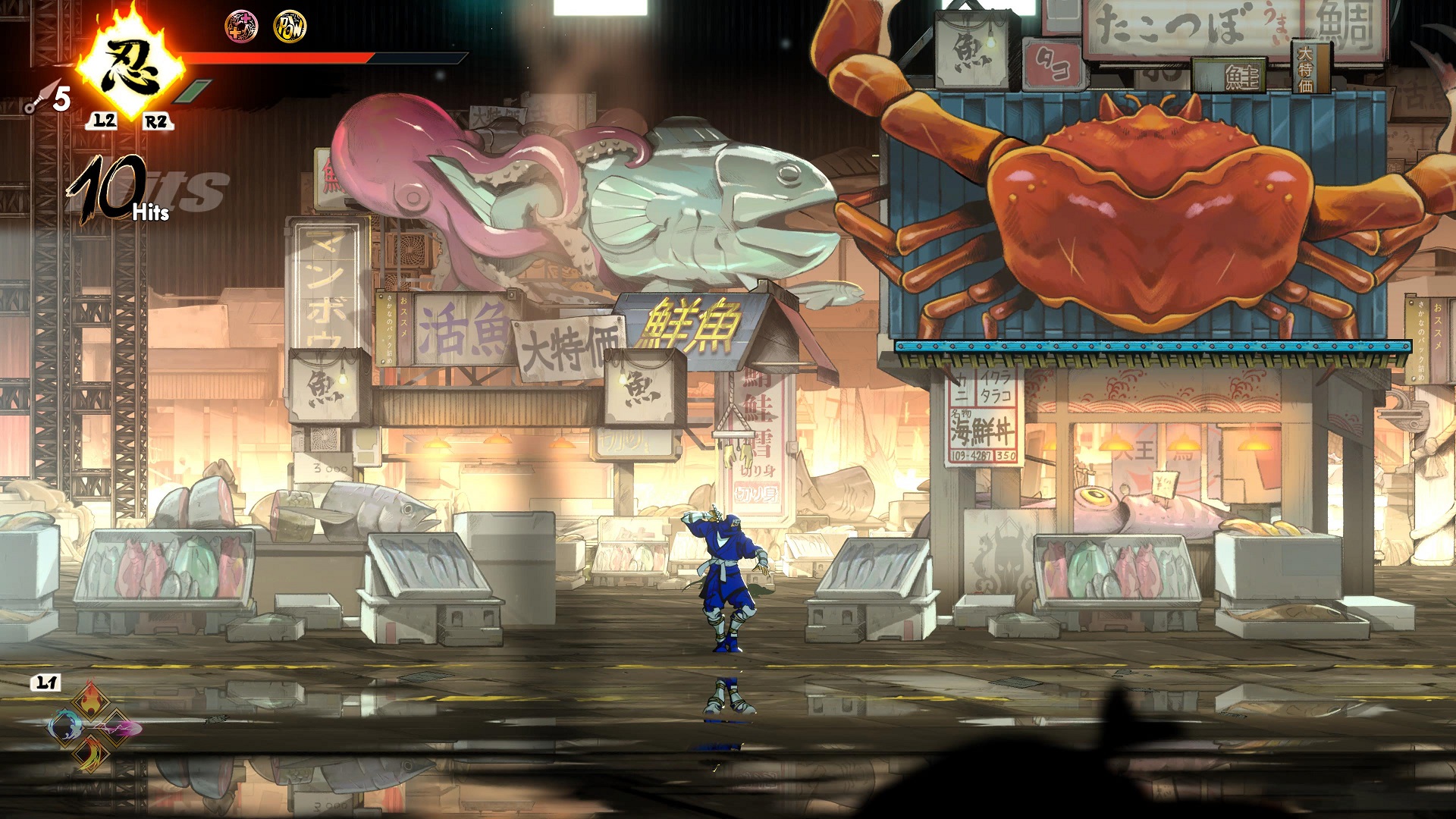GAME CLEAR No. 257 -- Shinobi: Art of Vengeance
video games game clear lizardcube sega shinobi ps5 playstationShinobi: Art of Vengeance (2025, Multiplatform)
Developer: Lizardcube
Publisher: SEGA
Clear Version: PS5
Clear Platform: PS5
Clear Date: 9/25/25

| Why should I care? |
|---|
| Although it didn’t quite hit the mark for me, Art of Vengeance is at least a beautiful entry in the classic SEGA series with some good ideas when it can get out of its own way. |
Slow ninja, slow ninja, slow
As is probably pretty obvious to anyone who’s read more than a couple of my posts, I don’t tend to agonize over them. Unless I really think I have a nice thought or trenchant insight to share, these GAME CLEARs mostly serve as a game diary for me. I like to highlight a couple things I enjoyed, maybe note some things that could’ve been a little better, and I try to generally provide a clear impression that I do or don’t recommend a game in a thumbs up/thumbs down kind of binary (I find scoring kind of repulsive and sort of hate the way it shapes the discussion of games). Sometimes I’ll try to be a bit more thorough or will revise a draft a couple times, but as much as anything, this blog is here for me to be able to look back and see what I played and what I thought of it. I appreciate anyone who takes the time to read these, but I also sometimes cringe to think that folks who read these may be under the impression that I consider most of my posts to be my best work or even particularly good work at all. I certainly do not. They are often hip-fired, so to speak, and they could all benefit from significant editing. All that is to say that while many of my posts are somewhat breezy streams of consciousness with only a couple of material criticisms or points made about a game wrapped in a low-stakes endorsement (or lack thereof), I’ve spent a great deal of time thinking about this one. The bottom line is this game really left me wanting, but I’ve been struggling to pinpoint why. If you care to, join me, and I’ll see if I can make my way to some points.
For the uninitiated, Shinobi is a classic SEGA platformer series starring ninja Joe Musashi. It’s not an A-list franchise for the company, but it had a strong series of respectable entries in the late ’80s and early ’90s as well as a handful of less-successful titles in the 21st century. In Art of Vengeance Joe’s back in action after the evil ENE Corp. wipes out his clan. When the game was teased a couple years ago, I was excited, especially once I learned it was being helmed by Lizardcube. Those guys made Streets of Rage 4, one of the greatest comeback titles ever and my favorite game of 2020. I thought this would be an outstanding game as well.
I’m sad to have been wrong, but I will dole out some praise for some of the things this game does do well, and unsurprisingly so given its development house. Like Streets of Rage and the Wonder Boy games that have received the Lizardcube treatment, Shinobi: Art of Vengeance is an absolutely stunning game visually. It has some of the prettiest 2D art you will find in games. I’ve included just one screenshot in this piece, but I think it is illustrative. Just about every corner of this game is as beautiful as that image. It’s unbelievable! The musical chops of veteran composers Tee Lopes and Yuzo Koshiro are also wonderful. The combat system is also cool and crunchy and deep and interesting. Like many good action games (and indeed Streets of Rage 4), I think I finished the game having mastered maybe 15-20% of Musashi’s kit, and I felt cool having done so!

The trouble is I don’t think a deep combat system is what this game needed. Much of what ails it, really, is how full it is of things it doesn’t need.
Like so many classic platformer revivals, Shinobi insists on being a kind of exploration platformer. You know, like some sort of Castlevania or Metroid game of unnameable genre. Maybe with some light puzzle solving. It’s a bit of a different pace from the original games, which were mostly simple, side-scrolling affairs. I don’t think this is necessarily a problem. In fact, I’m a big fan of the 2014 Strider revival, which also Metroidvania-izes a classic arcade/Genesis platformer. Although my memory of that game is now hazy, one thing I recall is that although the game became more labyrinthine, it lost none of its sense of speed with respect to either movement or slashing Strider’s sword. Those key pieces of identity remained. With Art of Vengeance, I often found the exploration to be tedious and slow or to lean too far away from what should be the core gameplay of running, jumping, slicing, and shurikening.
Additionally, rather than throwing mook after mook at you that can be deleted with a simple shuriken shot or sword swipe, Art of Vengeance prefers to have lengthy show-stopping encounters with groups of fairly meaty enemies. In fact, one of the game’s core mechanics depends on it.
Most non-boss enemies in the game have two bars: a health bar and an “execution” bar. You can fill the latter up by performing specific offensive moves on your enemies rather than just mashing. Once it is full, you can perform a special instant-kill technique. If you just mash the basic combo, you will deplete the life gauge first. You want to avoid this because executions yield greater rewards (in terms of gold, health pickups, and shuriken replenishments). In particular, you’d like to have as many enemies with full gauges on screen as possible because when many are chained in a single execution move, the rewards are even greater.
In practice, I found this seldom materialized. The problem is that even if you prioritize moves that boost execution gauges, those moves still do damage and will leave those enemies pretty close to HP death. Plus, they’re still alive, so it’s not like you can ignore them after that; they’ll continue to pursue you just like the other enemies you’re trying to fight. Often I found myself accidentally killing enemies I hoped to execute while trying to raise the execution meters of other bad guys. At its best, it is pretty satisfying, but those payoffs were few and far between in my experience.
But above all, just like the exploration and puzzling aspects, the combat encounters really seemed to drag the pace of play to me. I admire how sophisticated and deep the combat system is. There are tons of unlockable moves that can lead to some really slick combos, but even that is somewhat kneecapped by the execution system. If the game wants me to kill enemies by execution, then it also necessarily doesn’t want me to perform huge sick combos on them until they die! It’s frustrating because there is extraordinary effort here to make something cool that unfortunately just doesn’t quite pan out.
I understand where this motivation to juice up the combat came from too. It’s the exact thing they did with Streets of Rage 4. The difference is enemy encounters in the original games were often lengthy and often stopped the flow of play until a group of enemies was defeated. Although I love a classic beat ’em up as much as the next guy, I can admit even beloved favorites like Streets of Rage 2 were fairly button-mashy affairs. Giving the characters much more expansive movesets in a modern game makes sense! It makes them greater vehicles for player expression and enjoyment and increases the skill ceiling when dealing with enemy encounters. It also does not fundamentally alter the flow of the game.
With Shinobi the big changes made seem to indicate some kind of reluctance to make a true, classic platforming product that the series was founded on. It’s not enough to have a solid, basic kit of moves, easy (but numerous) enemies, and fast-paced action. Lizardcube or SEGA or both seemed to think it was necessary to expand on a formula that had no shortcomings to begin with. I know I keep coming back to it, but it’s vexing because Streets of Rage 4 is such a classic, traditional side-scrolling brawler that leans heavily on the fundamentals. It doesn’t try to be much “more” than the original games. Sure, they added a (critically acclaimed) roguelite expansion later, but the base game is a very old-school product. I wish they’d had the confidence to stick to the basics here as well.
It was a funny feeling putting this game down after the credits rolled. Earlier this year, I played Ninja Five-O, a little ninja platformer for Game Boy Advance. I would not have predicted in a million years that between it and Art of Vengeance I’d like Five-O better, but I felt immediately that that was the case. It’s just snappier and better paced.
Shinobi: Art of Vengeance really, truly is not bad, though. It is more disappointing than it is bad. It has strong moments, but the lack of great flow between them kept this from being the exceptional game I had hoped it would be.